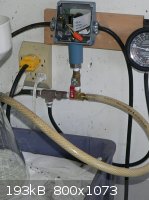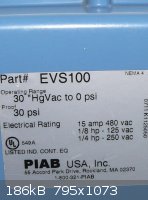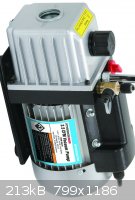mophead
Harmless

Posts: 10
Registered: 13-10-2004
Member Is Offline
Mood: No Mood
|
|
Vacuum sources and issues
I recently acquired a used HVAC vacuum pump and brand new digital vacuum gauge. I changed the oil, removed the large flare fitting, put a ball valve
and nipple where it will be useable with vac. hose. The best it will do is 550 microns when i hold my mouth just right. Average is ~700 microns.
I also have a water aspirator, running 45 deg(f) water through it with full bore will not even show a reading on the vacuum gauge (gauge will not
activate over 12,000 microns).
The HVAC pump is too strong to to vacuum distill anything like DCM, it shoot right through the condenser, and the aspirator seems a little weak (it's
running off a pond pump which is also shared with a chiller unit - I'm not hip on wasting water  ). ).
What is the best way, in your opinion to use the big pump for low boiling solvent recovery? A calibrated leak is doable, but it likes to spray oil
from the exhaust when there is air running through it, even with the built in air bleed screw.
Ideals? Suggestions?
Thanks,
mop.
|
|
|
bahamuth
Hazard to Others
  
Posts: 384
Registered: 3-11-2009
Location: Norway
Member Is Offline
Mood: Under stimulated
|
|
Why would you want to distill DCM (I guess you mean dichloromethane) under very low pressure? You could almost distill it with the warmth of your
hand...
Rotary vane pumps are usually very bad to use for distillations due to the nature of the pump, soaked in oil etc. without a very very good
trap/recovery system.
Anyways, if you want to distill DCM with it you could just use the ball valve to evacuate the apparatus very slowly as to let it cool to sub zero
temps so the DCM only will distill slowly. This applies to other solvents to except high boiling ones.
Also, 500 millitorrs is very bad for such a pump, I'd expect more like 5 millitorr, so you could have a leak, even a tiny tiny one will do that to
your pressure.
My water aspirator gets to around 300 millibar so don't expect to measure that one with a very low pressure gauge.
Do you plan to use the pump to evacuate a rotary evaporator or just on a regular distillation apparatus? Ask because DCM removal is done in a jiffy
with a rotavapor and an aspirator in my experience, HVAC pumps are for distilling stuff with a bp. over 150-200 degrees Celsius to through a
short-path to avoid decomp. IMO.
Solvent resistant diaphragm pumps are my choice in regards to solvent removal or distillations of low bp. stuff.
Any sufficiently advanced technology is indistinguishable from magic.
|
|
|
Doc B
Hazard to Others
  
Posts: 107
Registered: 5-4-2012
Member Is Offline
Mood: No Mood
|
|
Regarding the water aspirator: The water flow rate from a pond pump may be insufficient to provide any useful vacuume. Since you're not keen on
wasting water the only two suggestions I can offer are to either; 1) use your mains to power it, collect that which passes through and reuse that
water for another purpose. E.G. wash your glassware in, water the garden, drown cats.... 2) get a pool pump or similar that will provide a flow rate
similar to mains at full ball. Connect that to a drum, large bin, etc, from which you can route water to the pump and reroute from the aspirator back
to the drum.
I would distil DCM at atmospheric pressure. Using reduced pressure to distil low B.P solvents is going to leave you with the problem of having to
chill the receiver down to sufficiently low temperatures to stop the distillate from vaporization. Even an additional condenser running ice cold in
addition to an ice/water packed receiver flask is going to see DCM and the like exiting the system via the vacuume source.
|
|
|
kadriver
Hazard to Others
  
Posts: 196
Registered: 7-11-2012
Location: United States
Member Is Offline
Mood: Thankful
|
|
I have two HVAC pumps purchased from Harbor Freight, just like the one pictured below. They are tough and still in service.
I routinely draw on acidic and chlorinated solutions so I must change the oil frequently.
Pump 1 was bought back in Oct 2010, #2 was bought last June 2012.
I rotate them out every other month and change oil.
The pump draws on an eight gallon air compressor tank.
The tank draws on a 15 foot section of hard air hose.
The air hose draws on the vacuum filter flask.
I was having problems with filter papers failing due to the vacuum being too high.
I had to manually operate the switch to the pump, turning it on until the vac was at 5 inch Hg, then off.
When the vac bled down to 2 inches, I would manually start the pump motor until 5 inches Hg was reached then shut the pump off.
I spent hours sitting in front of the filter flask manually operating the vacuum pump motor.
Then I bought a vacuum operated switch from an Ebay seller - $65 including shipping.
It automatically turns the pump motor on and off according to my presets.
Now I just set the vacuum (adjustable from 0 to 30 inches) where i want it. It has about a 4 inch Hg dead band (turns on at 1 inch Hg, then off at
about 4 or 5 inches Hg.
I can walk away from the vacuum filtering station and do other taskes, and I have not experienced a filter paper failure since I installed the switch.
It was easy to install and works perfectly. If I get a bunch of silver chloride in with my dissolved gold, I can let the filter go all day long
(because the AgCl gloggs the filter). But the AgCl glogged filter tends to to a great job of removing very tiny suspended particles.
Hope this is helpful.
kadriver
  
|
|
|
chemrox
International Hazard
    
Posts: 2961
Registered: 18-1-2007
Location: UTM
Member Is Offline
Mood: LaGrangian
|
|
"What is the best way, in your opinion to use the big pump for low boiling solvent recovery? A calibrated leak is doable, but it likes to spray oil
from the exhaust when there is air running through it, even with the built in air bleed screw."
Check the oil level and angle of the pump at rest. It shouldn't spray oil. Low boiling solvents require at least one vapor trap if you don't want to
fight the solvent vapor pressure, change oil every day of use and replace seals frequently. You can use dry ice/acetone to cool the trap. One trap
using dry ice/acetone should work fine for DCM @ 1 torr. 0.5-1 torr is pretty good for an HVAC pump what's the problem? The best aspirator I have is
an all glass device I bought in a lot of used equipment. It pulls 5-10 Torr so I have to use a needle valve to maintain the ranges I normally use.
Vogel's 3rd pp 114-115 shows the two devices I use for controlling vacuum at the aspirator. I would use a good aspirator for solvent recovery but to
be able to re-use solvents there are a lot more steps depending on what you're using the DCM for. If you have to do slow fractional distillations
using variable takeoff and high efficiency column and steam distillation with drying you might be using more energy and material than is warranted.
BTW There are some oil-less pumps some members have that are very nice in the 0.1-10 Torr range. You simply have to watch the used equipment sources
until you can get one cheap enough. If you want you may u2u me about the specific application.
"When you let the dumbasses vote you end up with populism followed by autocracy and getting back is a bitch." Plato (sort of)
|
|
|
mophead
Harmless

Posts: 10
Registered: 13-10-2004
Member Is Offline
Mood: No Mood
|
|
I'm not actually stilling dcm at .7torr. It was just an example to get some ideals for lower boiling solvents. The aspirator is too little, the HVAC
pump is too big.
Thanks for the replies so far.
mop.
|
|
|
kadriver
Hazard to Others
  
Posts: 196
Registered: 7-11-2012
Location: United States
Member Is Offline
Mood: Thankful
|
|
If I was trying to get a slight vacuum (1 or 2 inches Hg or less) then I would buy a small globe valve ($5 at the hardware store) and a "T" fitting to
fit the globe valve.
A globe valve is the same kind of valve on the faucet for your garden hose. Globe valves are best for throttling fluids and air.
Connect the "T" fitting BETWEEN the right-hand side of the globe valve and the condenser you want evacuated.
Connect a vacuum gage (Harbor Freight about $24 for testing diesel engines) to the "T" fitting.
Then connect the left-hand side of the globe valve to vacuum pump or to the vacuum reservoir (your pump should draw on some sort of reservior instead
of drawing directly on the item being evacuated).
After starting the vacuum pump, you could then slowly crack open the globe valve and regulate the amount of vacuum communicated to your condenser,
monitoring the vacuum with the gage connected to the "T".
As the vacuum pump draws a greater vacuum, you can throttle down on the globe valve to keep the vacuum going to the condenser where you want it.
You could probably get the vacuum to the condenser to 1/2 inches of mercury or less. But you would need to adjust it continually - especially if you
have no reservoir.
If the glassware connections are tight, you could probably just charge the distillation apparatus with the amount of vacuum you desire, then turn the
vacuum pump off.
kadriver
|
|
|